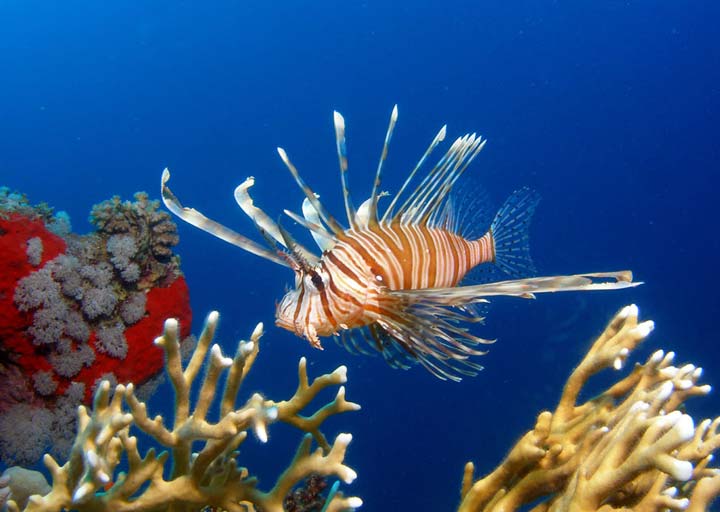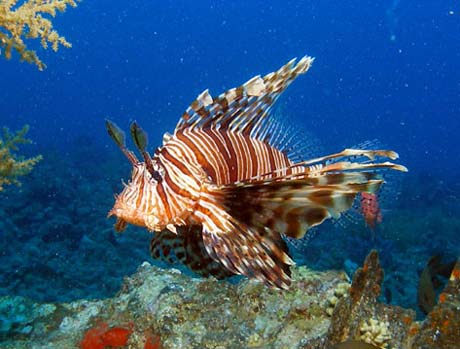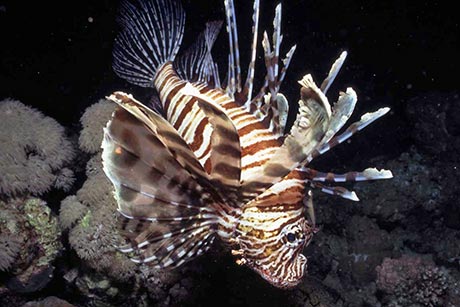Reviews: "Love the newsletters! Keep them coming" Janice Fleming...MORE REVIEWS

Lionfish, Pterois miles, Beautiful but Deadly
13 March 2024
Found naturally in the Red Sea and northern Indian Ocean. Elsewhere replaced by the very similar P. volitans. They often shelter under ledges during the day, becoming more active at dusk and during the night when they feed on fishes and crustaceans. Lionfish use their non-stinging pectoral fins to shepherd fish into their mouths. Their poisonous spines allow the fish to be conspicuously coloured, warning predators to keep their distance.

Lionfish (Turkeyfish), Pterois miles, over soft corals
Photo by Tim Nicholson.
Taken on Little Brother in the Egyptian Red Sea.
The Lionfish themselves tend to prey on almost anything they can find, small fish, invertebrates, molluscs… The larger specimens may even prey on juvenile lionfish. Some have been found with up to 6 different species of prey in their stomachs. Whilst hunting they are thought to shoot out jets of water to disorientate or stun their meals, as well as to herd fish towards them with their fins.

Photo by Tim Nicholson.
They have several adaptations, the most dangerous is the venom contained in the 11 dorsal fin rays on the back of the fish. A sting from a lionfish can be very painful, and possibly fatal, to divers. This venom can cause nausea, dizziness, breathing difficulties, and in some rare cases, limb paralysis and death. To treat a sting from a lionfish, immerse the wound in hot water then consult a doctor.
Juveniles show a unique adaptation, they possess a tentacle above their eye sockets which is possibly used to attract prey.

Photo by Tim Nicholson.
The fish can live for 15 years.They spawn every four days, year-round, producing around two million floating eggs a year. These travel in water currents for about a month before they settle, sometimes large distances away. This has made them very effective invaders of foreign territories.
Lionfish invaders are perhaps most famous for the speed in which they have colonised the east coast of the Americas, stretching from the Delaware Bay near Philadelphia down to Brazilian waters and everywhere in between. Most of these are of the species P. volitans, but about 7% are P. miles2. Lionfish may have been introduced into Atlantic waters from private owners who found they could no longer look after their pets when they became too big for their fishtanks. The invaders have reduced the abundance of small native reef fishes by up to 95% at some sites.
The problem isn't confined to the Americas. Pterois miles are now also being found in the Mediterranean and scientists are urging divers and fishermen to remove them when they find them. Research shows that culling can reduce lionfish abundance substantially, but removal rates must be high.
Lionfish are not a problem in their native home - fish know to be wary of them and predators like sharks, cornetfish, grouper, large eels and other scorpionfish will eat them.
Further Reading and References
Lionfish begin invasion into Mediterranean Sea: Cyprus already colonised. SCUBA News
Coral Reef Guide Red Sea by Ewald Lieske and Robert Myers, Harper Collins
2Invasive Species of Florida's Coastal Waters: The Red Lionfish (Pterois volitans) and Devil Firefish (P. miles), University of Florida.
by J Studholme

